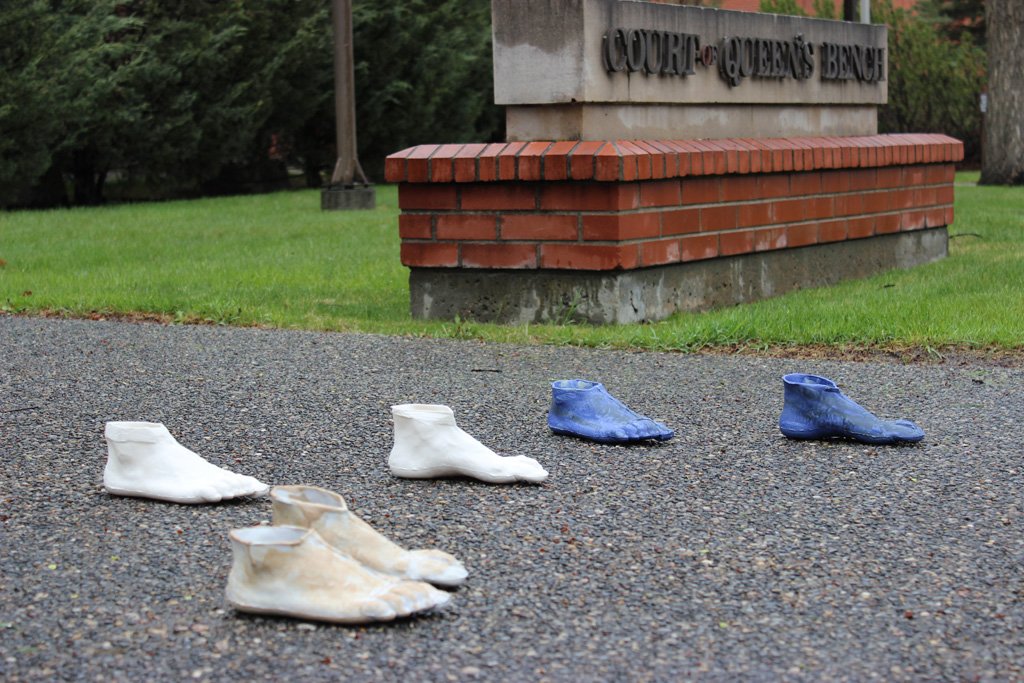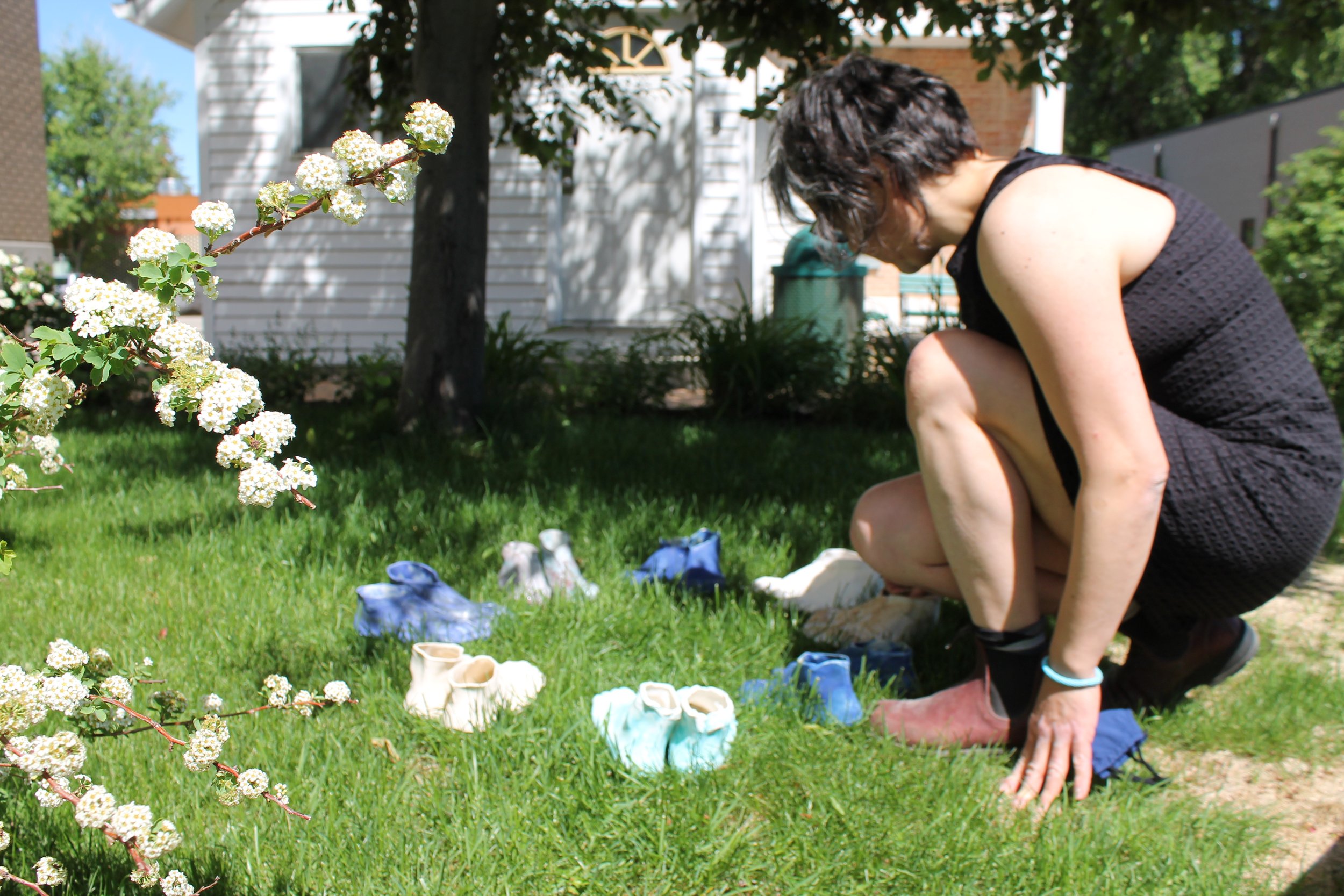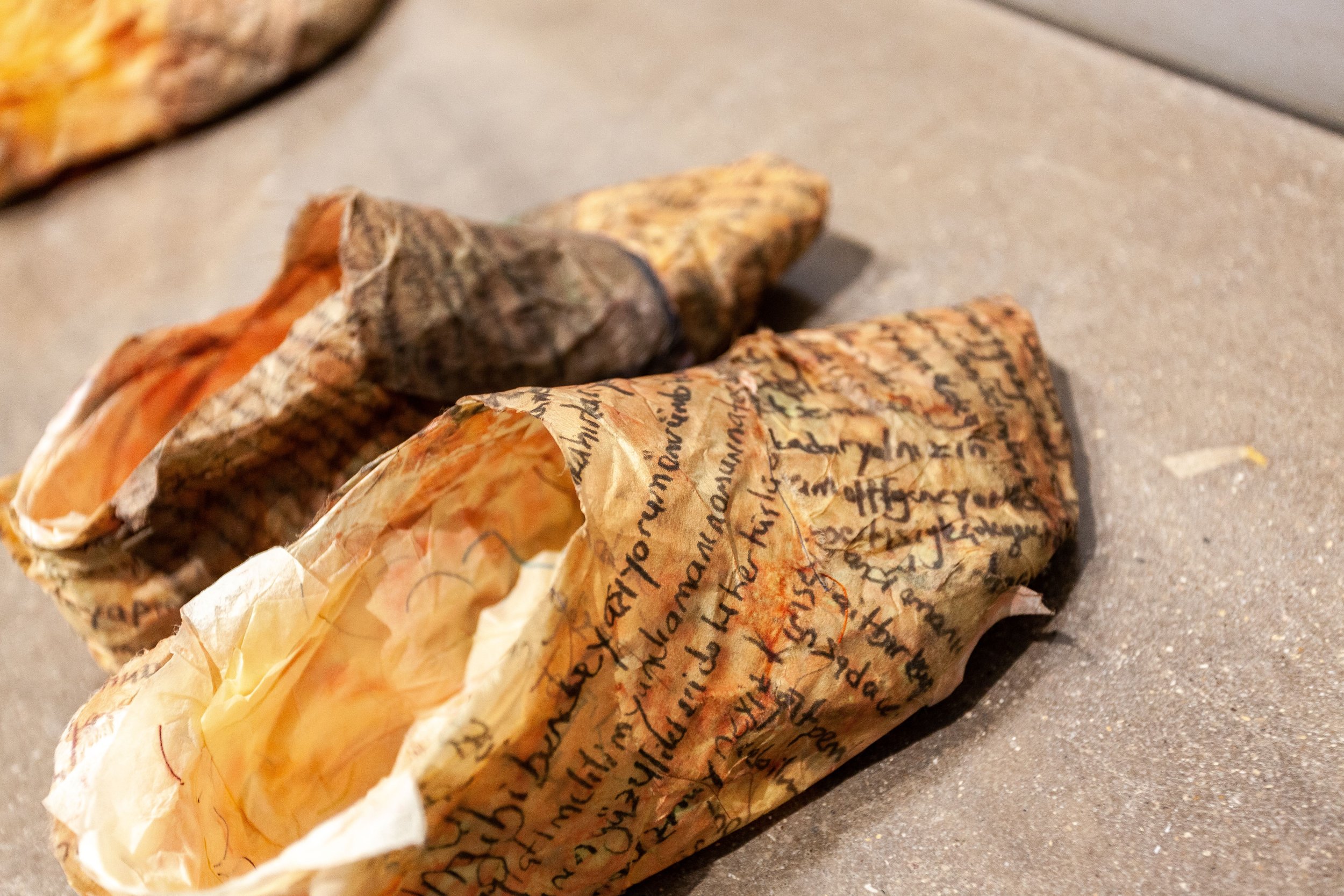Interview with Nurgül Rodriguez Part Two
Nurgül Rodriguez, His·to·ry on strange soil, 2021. Porcelain, photography, public intervention / performance, Provincial Courthouse, Stop 2, Historical Walking Tour: Downtown Medicine Hat. Courtesy of the artist.
This is Part Two of a three-part interview. Read Part One here.
Alana: Author, social justice facilitator, healer, and doula adrienne maree brown writes about vulnerability as “the least obvious path to the life i want, and the most liberating. it transforms the unknown from terror to possibility, evolves my actions from control to complexity.” There are layers of vulnerability in your work that create an entry point for people to engage in the complexity of the subjects you are speaking to and the materials you work with.
In some of your work, this happens through direct participation. Audiences navigate a space or a process and how they participate will impact the form of the work. I am thinking about A LOT TO LEARN (2018) and Out of Place (2019-2020) where the audience is implicated in the work as they navigate a process or a space through the objects you have created. Materials may be dispersed into the world through audience engagement, or they might be altered or destroyed. There’s a vulnerability in creating work where you give up control when others become active participants.
Can you talk about the role of vulnerability in your work and in His·to·ry on strange soil, a response to the historic walking tour in Medicine Hat?
Nurgül: When I was doing my first work for my final exhibition in my MFA, you have to test your exhibition until you conclude what is going to be in your final exhibition, it’s a process. I had a studio visit. We were discussing why I wanted people to step on the ceramic tiles. I explained that there is a waste of knowledge there. I want to show it. It is still there but it is broken. Initially, I wanted to cover the whole floor of the gallery with ceramic tiles. Then finally, although the whole floor was not covered, when people entered, in order to access the other side of the gallery, they had to step on the tiles, and then they started to be broken. One of my friends said, “Oh, my English is broken here. My language is broken here.” He didn’t like to see the broken words and to see people stepping over them.
Another vulnerability is knowing that this thick accent in my mouth is not going to change. I came here after age 39. It is part of my life like many others. I was reading the other day, about immigration. Our vulnerabilities are coming from the systems we move through.
I believe it will change but people don’t dare change. People who have money are comfortable, they don’t want to change it, but it is cracked. Things are going to change. Our transformation might start individually but it can’t rely on individuals alone. Change needs to be systemic.
This historic walk made me think about these things realistically. I have to be realistic; I am an outsider, things are not going to change but at the same time, things are changing. This is where art has a role to contribute.
I want to develop a socially engaged artwork, something to get others more involved in completing the work. Now I even want to bring the knowledge of others into the work. I want to bring the home spoken languages into the work and I want to bring painting, drawing, and writing to create a collective community.
Nurgül Rodriguez, Out of Place (2020) at Remai Modern as part of the exhibition borderLINE.
A: Your body is central to this piece and many of your other works. You have written about using your body as “the primary source because casting allows you to see yourself from a new perspective.” What is it like to see yourself from new perspectives? Can you talk about the perspectives that emerge through casting your own body?
N: There’s one reality when you are a more mature artist… When I was casting myself, I was thinking about how I studied a lot of different artists like Picasso, Goya, Kahlo… they portrayed themselves, but they were removing the egoism. [Self-portraiture] is not narcissism, but it could be perceived as such. If you don’t do the right reflection it’s understood as narcissism. For example, Basquiat, Andy Warhol, he repeated and repeated in his paintings. There was ego there. In a different way Francis Bacon was also repeating himself, but each time he was seeing different things, adding new values in the work. When I was casting my own body, still a Middle Eastern woman’s body, I was thinking about how I was different now.
I was brave, I have to say. As a woman, it looks like I’m brave, but conceptually brave, bringing my naked body in front of the viewer.* You touch your hand; you touch your feet, you see the quality of your body inside the cast. It’s so much emotion at the same time and I was thinking about all of these artists.
Sometimes I found myself crying. At the same time, at that time everybody had one concern: protect your body from COVID. In order to protect your body from the COVID-19 virus, you were away from your husband, you were away from your child who comes home from school, you can’t see your friends, you don’t get together. Don’t, don’t, don’t… many don’ts.
By bringing my naked body into an artwork, it was a tough decision, but it was the right time. By my life experience, aged experience, being able to experience many different cultures.
A: It can be a powerful thing to reflect on how we see ourselves differently throughout our lives and assert how we want to be seen.
In some of the photographs, we see you arranging the feet. This makes me think about having to position oneself in a particular way. Was that part of your intention in including your body in the documentation? Is it important to see you doing those actions or is it more important just to see the feet?
N: I appreciate this question, but at the same time, I didn’t have any intention that it was going to come out that way. With whom you work is very important. [Carmen] saw that these moments are important. She saw that the way I was looking at the sites and how I was moving and bringing the feet, and how I was placing them was important. It is its own process, a thinking process. We were following the prepared handout, the Historical Walking Tour. Carmen said, I am going to start shooting the in-between moments. It became like a performance. She has a background in theatre, so the performance became part of the work. She influenced the work. I told her, it wouldn’t be this way if you weren’t there.
We also started questioning what the role of the artist is because suddenly everywhere was empty. We became hollow. We couldn’t go out. Everyone is watching Netflix. I never got into it. I lived for many years without TV. What I am trying to say is, it was empty everywhere, no musicians, actors, stages were empty and then we found ourselves outdoors creating this work. Carmen’s participation became part of the work. Later when I was seeing the documentation, I figured out something… it shows the “as if”. It is as if I am trying to understand the people that were there.
Nurgül Rodriguez, His·to·ry on strange soil, 2021. Porcelain, photography, public intervention / performance, Ewart-Duggan House, Stop 8, Historical Walking Tour: Downtown Medicine Hat. Photos: Carmen Belanger. Courtesy of the artist.
A: Did you think about it as a performance or an intervention? Was it experimental? Did you plan it out?
N: Experimental. We are thinking to make it more. It’s still in process. I don’t have a synthesis. The experimentation became the most powerful side of the project.
A: It gives a sense of trying to figure something out.
N: What are we doing? Are we doing it right? We call this era post-colonialism, but it is not. When I find myself practicing colonialism I got scared. I said, “As if.” I said “no, I am not doing right.”
A: You had another artist residency in Medicine Hat at the Ewart-Duggan House which was supported by the Esplanade Art & Heritage Centre. The Ewart-Duggan House is also one of the stops on the tour. I am curious how your time there impacted how you chose to respond to this site?
N: Yes, I did a residency at the Ewart-Duggan House. During the residency I created a public program in connection with Landed, a 3-person exhibition at the Esplanade Art & Heritage Centre.
Artist residencies make any artist excited. I was happy because I had the whole house, and my family could come and go. When I arrived, the house was huge. I started questioning why I was in it alone. I was thinking about the space, the furniture, the land, from inside to outside. From the inside, I found the land and where all these breaks [from the land] are coming from. I felt in that house that the home I was missing was not in Calgary but the house I was born in, in Turkey.
For the virtual workshop, we invited immigrant people to write a letter from home at the Esplanade Arts and Heritage Centre (February 2021). My intention wasn’t art therapy, but it was therapeutic. We introduced ourselves, I discussed my artwork Letters from Home and explained that artwork. Everybody started writing creatively. People wrote in different languages. I wrote in Turkish. People wrote about many things. It was a very interesting experience. People told me they developed a connection to the gallery through the workshop, which they had not felt before.
Nurgül Rodriguez, Detail, A Letter for Home, 2020. Papier-mâché. Image courtesy of Spencer Shutte.
Nurgül Rodriguez, On the Wall, 2020. Linocut press print, turban cotton, ink, masking tape, 71" x 42". Image courtesy of Melissa Chinski.
A: Language plays an important role in your work. Words or text are inscribed into or printed and/or layered onto surfaces such as vessels or other materials or forms that often allude to the body. In your work you examine “how the power of language can form and shape immigrant individuals and diasporic bodies”.
Although this piece you created for Remediation Room isn’t text-based, it responds to the text and language of the historical walk in Medicine Hat. The walk is a text; a pamphlet that leads the public through the walk, pointing to the buildings and residencies that are deemed of historic importance from a white settler colonial lens. The historic buildings also have historic plaques.
Through performativity, experimentation, gesture, and the body, you point to the ways in which white settler colonial narratives are written onto and naturalized in public space. A powerful counterpoint to the pamphlet.
N: I was walking and following one text. When you want to live in another culture, you have to have a way to communicate. As a new settler, the first thing when I had to fill out paperwork, the first thing they ask is not your name, it is: which language do you want to communicate in?
This pamphlet is my guidance. I am directed, there is one orchestra. Who wrote that piece? I don’t know but I know that it is very powerful. It tells you that people came here, they struggled, they built these buildings. Following that text made me a more colonial person. Then it made me think about how we can decolonize.
During my MFA, many people were using the word decolonize. They want to decolonize their work. I was thinking, is this word really being used in the right way? Are we abusing this word? Then I figured out the word “acculturation”. My body is acculturated. So, I was thinking about these five stages of acculturation in this work as if I was practicing the five stages of acculturation.
Nurgül Rodriguez, His·to·ry on strange soil, 2021. Porcelain, photography, public intervention / performance, Ewart-Duggan House, Stop 8, Historical Walking Tour: Downtown Medicine Hat. Photo: Carmen Belanger. Courtesy of the artist.
This is Part Two of a three part interview. View more images of His·to·ry on strange soil by Nurgül Rodriguez here.







